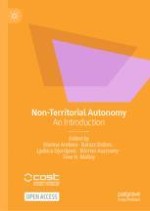Open Access 2023 | Open Access | Book

Non-Territorial Autonomy
An Introduction
Editors: Marina Andeva, Balázs Dobos, Ljubica Djordjević, Börries Kuzmany, Tove H. Malloy
Publisher: Springer Nature Switzerland
Open Access 2023 | Open Access | Book

Editors: Marina Andeva, Balázs Dobos, Ljubica Djordjević, Börries Kuzmany, Tove H. Malloy
Publisher: Springer Nature Switzerland
This Open Access textbook is a result of the work of ENTAN – the European Non-Territorial Autonomy Network. It provides students with a comprehensive analysis of the different aspects and issues around the concept of non-territorial autonomy (NTA). The themes of each chapter have been selected to ensure a multi- and interdisciplinary overview of an emerging research field and show both in theory and in practice the possibilities of NTA in addressing cultural, ethnic, religious and language differences in contemporary societies.
This is an open access book.